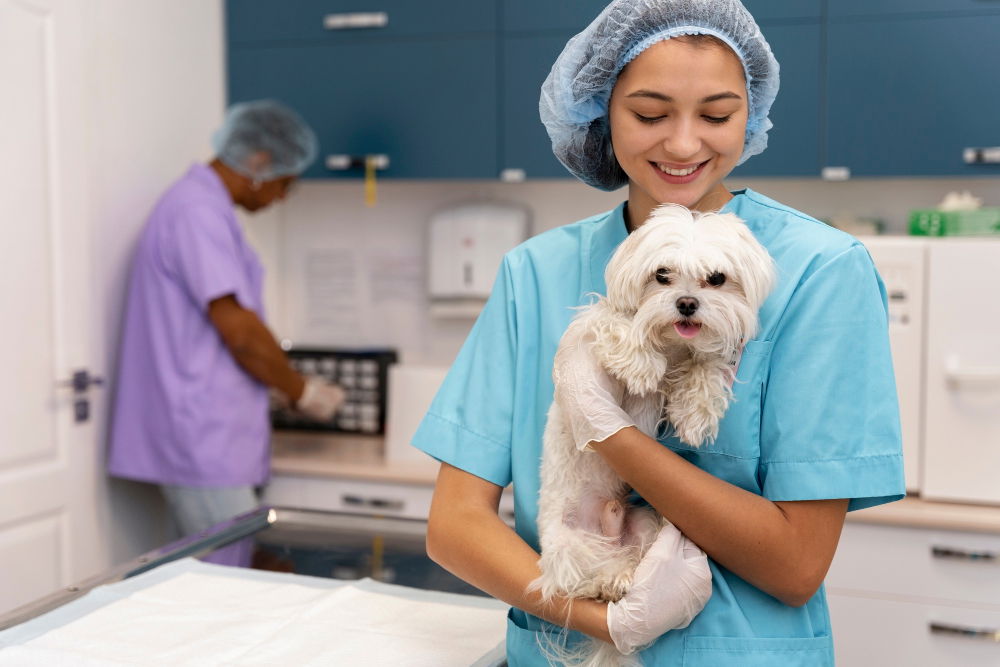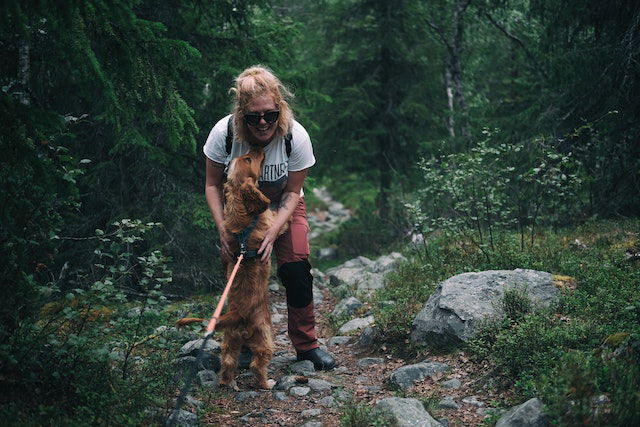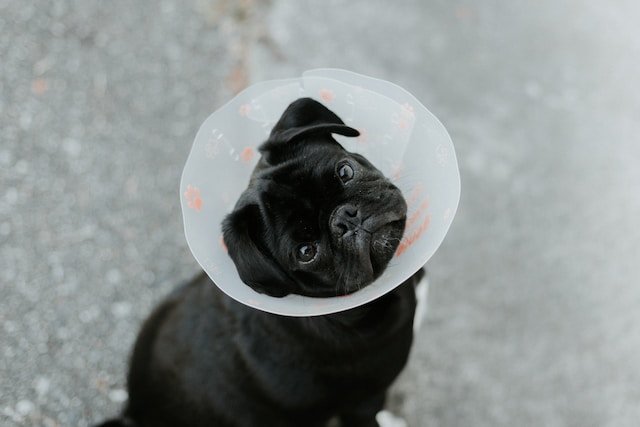We're an affiliate
We hope you love the products we recommend! Just so you know, we may collect a share of sales or other compensation from the links on this page at no additional cost to you. Thank you if you use our links, we really appreciate it!
Dog neutering involves simple surgical procedures, and they require ample rest during recovery time.
Some pet parents may lack a clear idea of how to take care of their neutered dogs. Your vet will most likely give you tailored advice on how to look after your dog during the recovery period.
There’s no denying that dogs who have been neutered don’t need physical activities post-surgery. It’s equally important to know when they can resume regular activities like walking and playing.
In this article, we have outlined all you need to know about dog neutering, and how soon you may resume normal physical activities after surgery.
What Is Dog Neutering?
Neutering is a surgical operation done by a vet that aims to remove the dog’s reproductive organs under general anesthesia. This procedure is also known as castration in male dogs, and spaying in female dogs.
In male dogs, neutering involves the process of safely removing one or both testicles, whereas spraying female dogs involves the removal of the uterus and ovaries.

Dog neutering is beneficial in several ways including:
- Removing the risk of developing testicular tumors in male dogs, and reducing the risk of acquiring uterus infections and cancers in females.
- Prevents female dogs from coming into season or attracting male attention.
- Spayed female dogs are less likely to become messy (bleeding) when they get in season.
- It may help to prevent certain medical conditions and unwanted behaviors in dogs.
- It reduces the use of urine as a territorial scent marker for dogs.
- Prevents unplanned puppies.
- Neutered dogs are less likely to roam around.
4 Common Myths About Neutering Dogs
Despite the potential benefits of neutering dogs, there has been no shortage of myths and misconceptions about this simple procedure.
Unfortunately, some dog owners are not easily convinced to alter their furry friends because of the following erroneous beliefs;
#Myth 1: Neutering will make a dog overweight or obese
This is one of the most held misconceptions about neutering dogs. Some people believe that altering the reproductive organs in dogs can make them add unexplained weight.
Fact: Your dog can only add too much weight when they overfeed or stay inactive by avoiding exercises that help burn calories.
While spaying or neutering may change a dog’s hormonal condition, it does not make them add weight.
You can maintain a healthy dog’s weight by providing quality portioned meals and taking the dogs out for regular exercise.
#Myth 2: Neutering will alter my dog’s personality
The other reason that makes some pet parents stay away from neutering, is the widely held belief that the surgery may worsen their dog’s personality.
Fact: A dog’s personality is NOT determined by reproductive hormones.
This surgical procedure will instead reduce some unwanted behaviors in dogs such as aggression in male dogs due to reduced testosterone hormone.
A neutered dog is also likely to form stronger bonds with their caregivers because they don’t have the urge to find a mate.
#Myth 3: Neutering a dog is an expensive process
Some dog owners are fearful of subjecting their lovely pups to this surgical procedure because they think it costs too much.
Fact: The cost of spaying or neutering a dog is relatively affordable compared to other surgical procedures.
The pricing of surgical procedures may vary with different clinics but they normally fall within the range of $50 – $500.
If you ask around, you may find some vet clinics within your community that offer free neutering services courtesy of subsidies from the local animal welfare agencies.
If you also think about it critically, it will cost you more to care for unplanned puppies than to pay for neutering services.
#Myth 4: Neutering a dog is painful and unsafe
Due to the incisions involved, some people believe that dog neutering is an unsafe and painful procedure, but nothing could be further from the truth.
Fact: Spaying and neutering are some of the most commonly performed surgical procedures in vet clinics for cats and dogs.
The surgical procedure is done under general anesthesia, meaning that your dog will not experience any pain during the actual operation.
The anesthesia effects may last for 24 hours after which your dog may have a little discomfort. The vet surgeon will prescribe an aftercare management plan to help your dog feel comfortable during recovery.
The Dog Neutering Procedure
Your dog will be examined at the vet’s clinic and undergo some blood work to carry out a pre-anesthetic assessment.
If the tests turn out positive, your dog will be anesthetized with an intravenous catheter. A breathing tube will be put across your dog’s windpipe for inhalation.
The vet will then shave and rub the surgical area (which is typically the skin in front of the scrotum and testicles).
Once this is done, your dog’s surgeon will make a small incision on the shaved area and push the testicle up to remove it through the incision.
On successful removal, the incision will be stitched using absorbable sutures in multiple layers as the vet checks for bleeding.
Spaying procedure
For female dogs, the vet surgeon will make incisions on the skin just below the belly button to remove the womb or both ovaries using a scalpel.
Once the removal is done, the vet will sew up the incisions using absorbable sutures, and they may use tissue glue to make the stitch better.
How Soon Can I Walk My Dog After Neutering?
After a successful neuter, your vet will recommend rest and restricted activity for your dog during a specific period to aid full recovery.
Most dogs, especially puppies, cannot sit still when they think they should be walking and roaming around the house.
In most cases, the neutered dog may appear to be all set for hitting the road just a few days after the surgery, but you should not give in to walking them.
Limiting your dog’s movements and allowing them enough resting time post-surgery is important because it supports faster healing.
Subjecting your recovering pup to strenuous activities may disrupt the healing process and sometimes it may pull apart the dissolvable stitches and rapture the stitched skin.
You should avoid walking your neutered dog for at least 7 to 10 days after coming from the surgery room.
This includes restricting the dog from making unnecessary movements, jumping up and down, or engaging in other physically intensive activities.
Once the dog completes 10 days after the surgery, you can gradually re-introduce them to regular physical activities, starting with short walks.

During the first few days, you may start with short-distance walks around the house and work your way out to the yard while monitoring the dog closely.
If your dog seems strong enough after a few days of brief walks, you may subject them to light exercises in a controlled area.
During the first two weeks, you may leash the dog and take them on outdoor walks over a manageable distance. Be careful not to overexcite the dog or induce them to vigorous exercises.
When taking your dog to the clinic for a check-up within the second week, your vet will examine the dog’s stitches and look for possible complications.
If the dog has fully recuperated, the vet will most likely clear them to return to regular physical activities and normal resting.
In the unfortunate situation that the vet discovers a complication with the healing process, they will work out a further treatment plan to prevent severe effects.
Potential Risks of Walking Your Dog Too Early
On the off chance that your neutered dog resumes normal walking before healing properly, they may risk suffering a few setbacks, including:
1. While straining to walk after surgery, the dog may rub the wounds and this will cause swelling and hamper the healing process.
2. Constant walking may break the stitches, cause accumulation of fluid in the surgical site, and bacterial infections.
3. It also comes with the extra inconvenience of having a second stitching which resets the recovery process.
4. Vigorous physical activity may expose the recovering dog to muscle strain, which causes pain in the wound and slows down the healing process.
The best thing you can do for your dog post-surgery is to follow your vet’s professional advice to the letter and be physically available to the dog.
Recovering dogs need plenty of attention, care, and the physical presence of their human caregivers.
Be ready to spend many hours with the dog and show them lots of love by petting, cuddling, and praising them.
If you’re not able to spend more time with your dog, we suggest that you look for a pet sitter to calm them with comfort.
Leaving your dog alone during this hour of need may predispose them to engage in physical activities, like walking and playing, and this will slow down the healing process.
Other Forms of Exercises to Try
While your neutered dog is resting and holding back from physical activities, it does not mean that they sleep all day without doing anything.
There are plenty of enriching activities that you can try with your dog to keep their brains working and prevent boredom.

Aim at using brain games that don’t require the dog to make physical movements. You can offer them food and toys in creative ways by using a puzzle feeder to reward every problem solved.
You can also use the recovery period to teach your dog new tricks and commands. Choose the commands that don’t involve walking, jumping, or vigorous movements such as ‘sit and stay’.
Frequently Asked Questions (FAQs)
1. Can I take my dog for shorter walks before the recommended timeline?
Supporting your recovering dog to make light short walks e.g., going to the bathroom area and back, is not harmful during the resting period.
However, you should avoid any other form of walking that doesn’t support your dog’s important activities of the day.
Most vets recommend a total restriction of all physical activities, including walks and games, until the dog fully recovers – and it’s important to stick to that timeline.
Taking your dog on unsolicited walks may strain their muscles and rub the wound. This may break apart the stitches and complicate the healing process.
2. What signs should I look for to determine if my dog is ready for longer walks?
For the most part, you should wait for about 10 days before allowing your dog to resume normal physical activities.
On the lapse of the recovery timeline, your vet will clear the dog for long walks after a check-up and confirmation of full recovery.
We don’t recommend looking at your dog for signs of readiness to resume normal walking. So long as your dog is not feeling pain at the wound, they will always be ready for activities.
Your dog doesn’t know they have a wound that needs rest and time to heal. You should be able to guide them and restrict strenuous physical activities to aid proper healing.
3. Can I let my dog off-leash during the recovery period?
Ideally, you should keep your dog in a well-furnished playpen during the recovery period, and only walk them with a leash for potty breaks.
Allowing your dog to walk off-leash from the resting zone to open spaces may entice them to jump, walk further, run, and even play.
Going off-leash also means that you have no control over the dog and they may run into hiding for self-entertainment. This poses a big risk to the stitched incision and may slow down healing.
Conclusion
You should wait for at least 7 to 10 days after neutering your dog before taking them out for walks.
Allowing the dog enough time to rest while restraining all unnecessary physical activities will help boost the healing process, and return to normal life in good time.
Remember to follow your veterinarian’s guidelines on after-surgery care, and report any complications as soon as possible.
After 10 days, you can resume short walks and take your dog to the vet for a check-up. If your dog has fully recovered, they will receive a green light to resume normal physical activities.
Laura is the founder of Furs'n'Paws. She is a also a pet writer and expert with more than 20 years of experience of working with dogs and cats. She developed a very strong love for animals at a young age. Her passion led her to establish a thriving pet sitting and dog walking business in Dubai. As an expert in pet training, behavior, and nutrition, Laura is committed to helping pet owners and pet lovers by offering high-quality information on a wide range of topics.



No responses yet